
Water Fountain
thingiverse
This project will empower students with the skills to craft their own functional water fountain. This model showcases the potential of what can be achieved through this project, demonstrating its versatility and adaptability for various skill levels, from novice to expert. The project provides a comprehensive list of materials required, along with detailed instructions on how to integrate them into the fountain's design. Note: Unfortunately, I was unable to complete printing my model due to a shortage of filament and lack of funds to acquire more. Designing My Fountain I designed my water fountain using two distinct software applications. Firstly, I created the general shape of the fountain in 123Design, defining the bottom collection pool, water path, and top collection pool. Subsequently, I transferred the model into Meshmixer to refine its appearance and give it a more organic look. Important Note When designing your own fountain, it is crucial to obtain precise measurements of the connectors, tubes, and pump to ensure a seamless fit. Project: Homemade Water Fountain Overview & Background Through this project, students will develop their skills in designing around objects with predetermined dimensions. Objectives The objectives of this project are to learn how to build from set dimensions, create models that appear organic, and connect simple electronics. Audiences This project is suitable for individuals as young as 14 and can be adapted for experts seeking a new challenge. Subjects The project covers various subjects, including Engineering, Art, and Electrics. Skills Learned Students will acquire the skills to properly measure objects, sculpt using Meshmixer, and connect simple electronics. Lesson/Activity 1. Decide on the fundamental aspects of your design. 2. Measure the pump and tube connectors provided. 3. Begin designing the fountain; start with the bottom collection pool and work upwards. 4. Keep the shape and details simple for now. 5. Once you have a rough design, import it into Meshmixer. 6. Use Meshmixer to make the fountain look more organic. 7. Once satisfied with your work, print the model; I recommend using ABS (with my model, I had to break it into three parts). 8. If the model needs to be divided into multiple parts, assemble them using ABS slurry. 9. Install the tube connectors once the model is complete. 10. Hook up the motor; I used an Arduino Uno because I plan on connecting LED lights to it. Alternatively, use a transformer. If an Arduino is used, simply plug the wires from the pump into the positive and negative terminals of the Arduino. If a transformer is used, solder the transformer to the pump. 11. Connect the intake of the pump to the tube connector on the bottom collection pool, and the output of the pump to the top collection pool. 12. To prime the pump, fill the top collection pool with water and allow it to flow down into the pump; also fill the bottom collection pool with water. 13. The final step is to paint the fountain. Duration The duration of this project varies depending on the complexity of the student's projects. My fountain took eight hours to design, one hour to assemble, and two days to print. Students can expect to complete the project within two weeks. Preparation Prior knowledge of CAD software is recommended. Rubric & Assessment By the end of the project, students should have designed a functional fountain that can hold water without leaks or spills, collects it in one place, and transports it to another location. The projects will be evaluated based on functionality and aesthetics, including the student's ability to make the model look organic using Meshmixer.
With this file you will be able to print Water Fountain with your 3D printer. Click on the button and save the file on your computer to work, edit or customize your design. You can also find more 3D designs for printers on Water Fountain.
